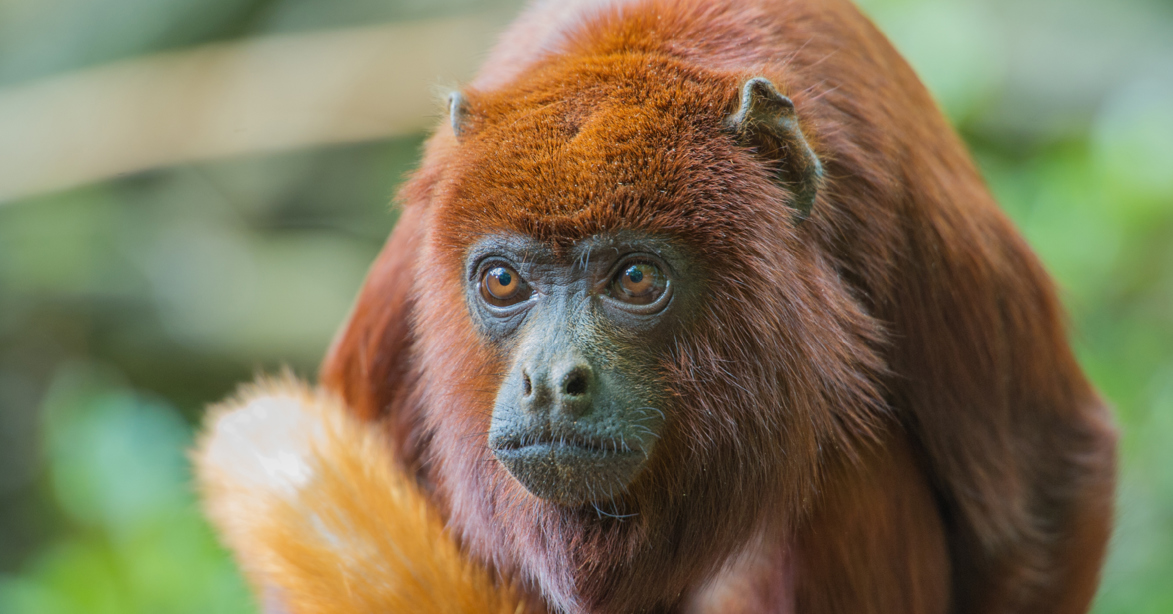Colombian red howler
Alouatta seniculus
Habitat
Tropical rainforest
Food
Leaves, flowers, fruits
Weight
♂ ± 7 kg | ♀ ± 5 kg
Age
15 to 25 years
IUCN Status
Gevoelig
Appearance
Like their name states, Colombian red howlers have a stunning red fur. However, their face appears completely different: hairless and black. Colombian red howlers also have a beard. The males’ beard is a bit darker than the female one. Colombian red howlers also have a prehensile tail, with which they can grasp on to their surroundings firmly and easily. The very lowest tip of this tail is hairless, which provides extra grip. So it’s kind of like a fifth hand (or feet)! And obviously, like their names says, these primates are known for their loud howling. This is how they signal their territory to other animals.
Habitat
In the wild, Colombian red howlers live in the tropical rain forests of South-America. To be more specific in Colombia, Venezuela, the Guyana’s, East-Ecuador and the North of Peru. They live high in the treetops and sometimes make an excursion to the ground to forage for food.
Lifestyle
Colombian red howlers live in groups of about 6 to 10 individuals. One adult male is the leader, only he is allowed to mate with the females.
Behaviour
Colombian red howlers live high up in the trees. They’re not very active animals and rest a lot. This is because digesting the leaves they eat takes up a lot of their energy. They can’t just spill any of it, so they take it easy. In the wild Colombian red howlers howl multiple times a day. The sound of the males starts out soft and increasingly gets louder. It can often sound like a storm breaking out! Other red howlers join in afterwards, the howling can be heard from up to about 3 kilometres away. This howl is a smart way to efficiently distribute their energy. They scare away intruders with it, taking up a lot less energy than actually confronting them.

Reproduction
When the Colombian red howlers are about 4 or 5 years old, they give birth to their first offspring. The men with which they mate are often a bit older, around 7 or 8 years old. The gestation period in the wild is about six months. After birth, the mother carries the young on her belly, where it later moves to their backs. Living in a group often has its advantages: all females in the group absolutely love to help with taking care of the other offspring.
Both the male and females leave their natal group when they’re fully grown and ready to independently take care of the young.
Situation in the wild
The Colombian red howlers are officially not endangered. However, there are looming threats to their habitat. Even more forests are being cut down, and the howlers are being hunted. Luckily there are over 32 protected national reserves in Colombia, Ecuador, Peru and Venezuela in which these animals are able to live a relatively safe life.

At Apenheul
The Colombian red howlers in Apenheul roam freely among the visitors, in the Primate Treetop Walk. This path walks in between the treetops, so you can discover the Colombian red howlers at eye-level!
Population management programme
Apenheul is part of the European endangered species programme (EEP) for Colombian red howlers. By working together with other zoos we ensure a genetically healthy and demographically stable population of this species is maintained in zoos.
Fun facts
- Colombian red howlers have a prehensile tails. This makes them belong to the “prehensile tailed monkeys”, together with the spider monkeys and woolly monkeys.
- The Colombian red howlers adore young and fresh leaves. However, these don’t grow on the trees in the Netherlands for the entire year. So we freeze in a large batch during the spring, so that we can always give these animals a fresh meal! You can kind of compare this to our frozen vegetables.
Want to see the Colombian red howler at Apenheul?
Get your tickets now and roam freely among the primates!

Welcome to Apenheul
Open every day
from 10.00 until 17.00